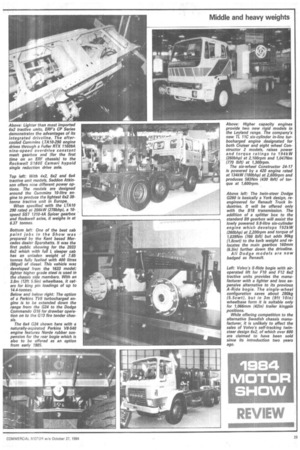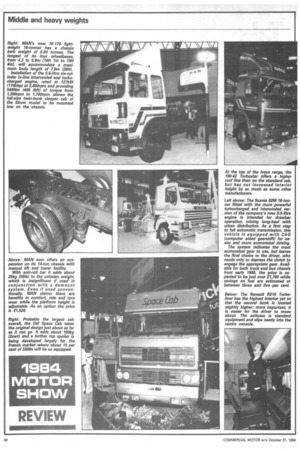These 6x2s are advancing in a big way
Page 34

Page 35

Page 36

If you've noticed an error in this article please click here to report it so we can fix it.
VISITORS' ideas at motor shows trends in development are more often than not disputed by engineers and operators generally. What there can be no argument about when reviewing the 1984 Motor Show is this: the choice of 6x2 tractive units has increased dramatically since the last Show at the National Exhibition Centre in Birmingham.
It is estimated that just over 20 per cent of all tractive units now sold have three axles, while the figure is more than twice that for those that operate at the increased 38tonne maximum legal weight.
More powerful engines have been developed to match both the demands of that increase in gross vehicle weight and higher road speeds.
Much less pronounced is the move to drawbar operation, still limited by a 32-tonne maximum weight. However, drawcpars are growing in popularity with own-account operators who appreciate the benefits of operating stockless depots and are able to make use of maximum-platformlength vehicles.
Air suspension is gaining wider acceptance slowly but is only specified on rigid chassis in conjunction with demount application or where operators are carrying customer's goods of a fragile nature. On the Continent, where the trend is towards softer springing of urban delivery vehicles than is the case in the United Kingdom, some manufacturers offer full air suspension front and rear.
However, while in Britain the availability of rear air suspension on tractive units has grown, there was not much evidence of it at this Show except where it was incorporated in the rear suspension of 6x2 twin-steers.
Both medium and heavy cabs have been updated and have improved trim. And while for the majority these are only detail changes, some manufacturers have provided their top-ofthe-range models with a welcome extra degree of interior room.
Left: The only truck chassis on the Hestair Dennis stand was equipped with a second steered axle engineered by York Technical Services. The 77m (36ft) Delta chassis side members were specially rolled in one piece for the chassis cowl which will form the basis for the new generation of BBC outside broadcast vehicles, with a plated gross vehicle weight of 22 tonnes. Its Perkins TV8-540 7 60kW (215bhp) engine drives through an Allison MT643 five-speed automatic transmission with torque converter. Above: Lighter than most imported 6x2 tractive units, ERF's CF Series demonstrates the advantages of its Integrated driveline. The aftercooled Cummins LTA10-290 engine drives through a Fuller RTX 11609A nine-speed overdrive constant mesh gearbox and (for the first time on an ERF chassis) to the Rockwell S160E Cameri hypoid single reduction drive axle.
Top left: With 4x2, 6x2 and 8x4 tractive unit models, Seddon Atkinson offers nine different power options. The models are designed around the Cummins 10-litre engine to produce the lightest 6x2 38tonne tractive unit in Europe..
When specified with the LTA10 290 rated at 208kW (278bhp), a 10speed SST 1310-4A Spicer gearbox and Rockwell axles, it weighs in at 6.37 tonnes.
Bottom left: One of the best cab paint jobs in the Show was prepared by the Kent based Mercedes dealer Sparshatts. It was the first public showing for the 2033 6x2 which with full L sleeper cab has an unladen weight of 7.65 tonnes fully fuelled with 400 litres (88gal) of diesel. This vehicle was developed from the 1633 model; lighter higher grade steel is used in the chassis side members. With an 3.8m (12ft 5.5in) wheelbase, it caters for king pin loadings of up to 14.4-tonnes.
Below and below right: The option of a Perkins TV8 turbocharged engine is to be extended down the range from the 024 to the Dodge Commando 016 for drawbar operation on to the G13 fire tender chassis.
The 6x4 024 shown here with a naturally-aspirated Perkins V8-5.40 engine features Norde rubber suspension for the rear bogie which is also to be offered as an option from early 1985, Above: Higher capacity engines provide two new rigid models in the Leyland range. The company's new IL 1IC six-cylinder in-line turbocharged engine designated for both Cruiser and eight wheel Constructor 2 models, raises power and torque ratings to I94kW (260bhp) at 2,100rpm and 1,047Nm (770 lbft) at 1,300rpm.
The six-wheel Constructor 24-17 is powered by a 420 engine rated at I34kW (180bhp) at 2,600rpm and produces 583Nm (430 Ibft) of torque at 1,600rpm.
Above left: The twin-steer Dodge G260 is basically a York design, reengineered for Renault Truck Industries. It will be offered only with the B18 transmission. The addition of a splitter box to the standard 89 gearbox will assist the lowly powered 9.8-litre six-cylinder engine which develops 192kW (260bhp) at 2,200rpm and torque of 1,039Nrn (766 lb It) but adds 90kg (1.8cwt) to the kerb weight and relocates the main gearbox 160mm (6.3in) further down the driveline.
All Dodge models are now badged as Renault.
Left: Volvo's S-Ride bogie with airoperated lift for FIO and F12 6x2 tractive units provides the manufacturer with a lighter and less expensive alternative to its previous A-Ride bogie. The single-wheel configuration saves about 280kg (5.5cwt), but in 3m (9ft 10in) wheelbase form it is suitable only for 1,066mm (42in) trailer kingpin positions.
While offering competition to the alternative Swedish chassis manufacturer, it is unlikely to affect the sales of Volvo's self-tracking twinsteer design 6x2, of which over 600 are claimed to have been sold since its introduction two years ago. Right: MAN'S new 16-170 lightweight 16-tonner has a chassis kerb weight of 5.03 tonnes. The longest of its four wheelbases, from 4.3 to 5.9m (14ft lin to 19ft 41n), will accommodate a maximum body length of 7.9m (26ft).
Installation of the 5.6-litre six-cylinder in-line intercooled and turbocharged engine, rated at 127kW (170bhp) at 2,800rpm and providing 549Nm (405 lbft) of torque from 1,200rpm to 1,700rpm, allows the full-size twin-bunk sleeper cab of the Show model to be mounted low on the chassis.
Above: MAN now offers air suspension on its 10-ton chassis with manual lift and lower facility.
With anti-roll bar it adds about 25kg (551b) to the unladen weight, which is insignificant if used in conjunction with a demount system. Even if used conventionally, MAN claims there are benefits in comfort, ride and tyre wear while the platform height is adjustable. As an option the price is £1,520.
Right: Probably the largest cab overall, the Oaf Space Cab takes the original design just about as far as it can go. It adds about 100kg (2cwt) and a further top spoiler is being developed largely for the French market where about 15 per cent of 33005 will be so equipped. At the top of the iveco range, the 190-42 Turbostar offers a higher roof line than on the standard cab, but has not increased interior height by as much as some other manufacturers.
Left above: The Scania 92M 16-tonner fitted with the more powerful turbocharged and intercooled version of the company's new 8.5-litre engine is intended for drawbar operation, mixing long-haul with urban distribution. As a first step to full automatic transmission, this vehicle is equipped with CAG (computer aided gearshift) for easier and more economical driving.
The system indicates the most economical gear to use, but leaves the final choice to the driver, who needs only to depress the clutch to engage the appropriate gear. Available for both truck and bus chassis from early 1985, the price is expected to be just over £1,700 while savings on fuel are estimated at between three and five per cent.
Below: The Renault R310 Turboliner has the highest interior yet so that the second bunk is located slightly higher; more important, it is easier for the driver to move about. The suitcase is standard equipment and clips neatly into the centre console.


















































































































